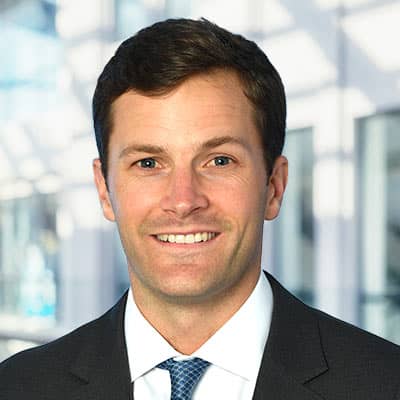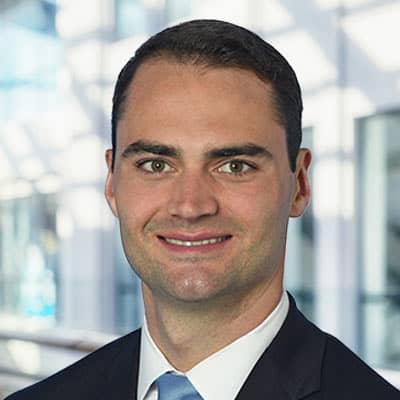At Fort Washington, we continue to monitor COVID-19 on behalf of our clients and employees. The situation continues to evolve rapidly, and the full impact of the virus is unknowable at this point. Since the initial December cases in Wuhan, China, investors have been challenged to gauge the severity and the duration of the virus. In the early stages after the initial cases, the U.S. equity market reaction was relatively muted as investors viewed the impact to corporate profits and economic growth as China-specific. As the outbreak crossed borders with elevated cases across several countries, investors increased their expectation for the economic impact of the virus. This coincided with news that an oil price war had started due to a dispute between Russia and Saudi Arabia. For the first time the global economy was experiencing simultaneous supply shocks.
The U.S. equity markets retreated rapidly into bear market territory. Swift, coordinated action in China and South Korea has caused new cases in the countries to peak and initial signs from the populations returning to normal routines have been favorable. As of this writing, President Trump, Congress, and the U.S. Federal Reserve are taking action aimed at enabling mass testing and/or reducing the virus’ impact on the world’s largest economy. “Social distancing” is in process in schools, attractions, and corporations. Fiscal policy targeting vulnerable segments of the U.S. economy is the next likely avenue of support. One of the key questions now is whether these preventative measures in the U.S. and other countries will result in a suppression of new cases similar to what we have witnessed in China and South Korea. With patient testing ramping exponentially in the coming weeks and real disruptions in travel, supply chains, and trade slowing economic activity, odds are high the volatility will continue.
Focused Equity & Large Cap Focused Equity Strategy
As the vibrations from COVID-19 spread continue to unfold, the negative effect will expand from consumer and energy companies to many other industries as changes in consumer behavior and supply chain disruptions lead to a slowing in economic activity. The initial wave of carnage has been most acute in travel and hospitality related businesses (airlines, cruise line, hotels, restaurants, rental car, etc.) and oil companies. The Focused Equity and Large Cap Focused Equity strategies currently have no direct weight in hotel, airline, or rental car companies. Although historically the strategies have had a material overweight to cruise stocks, the weight to this area had been pared back significantly in recent years, before the COVID-19 outbreak. The strategies have minor exposure to large cap restaurant holdings that have fared well to date relative to the restaurant components of the indexes. The strategies also have an underweight to the Energy and Materials sectors, which have experienced considerable weakness recently.
Geographically, the Focused Equity and Large Cap Focused Equity strategies are domestic equity strategies but have the ability to hold up to a 35% weight in foreign securities. Below is a view of the Focused Equity strategy’s revenue exposures to some of the countries most affected by the virus as of March 13, 2020. On the list below, China and South Korea seem to be in the recovery phase of the outbreak while the other countries, notably the U.S., are in the earlier stages of the virus spread.
| Fort Washington Focused Equity | Russell 3000 INdex | |
|---|---|---|
| Country | ||
| China | 9.0% | 5.6% |
| Italy | 1.2% | 1.0% |
| Iran | 0.2% | 0.2% |
| South Korea | 0.9% | 1.0% |
| Spain | 0.8% | 0.8% |
| France | 1.4% | 1.3% |
| Germany | 2.5% | 2.2% |
| U.S. | 58.3% | 63.4% |
| Switzerland | 0.4% | 0.4% |
Source: Fort Washington, FactSet. Russell Investment Group is the source and owner of the trademarks, service marks, and copyrights related to the Russell Indexes.
As an investment team, our current framework for thinking about the potential impact of COVID-19 is characterized by several important themes.
- Although this is a novel virus that poses many unique challenges, there is precedent here looking at several past health scares including SARS, Avian Flu, Swine Flu, MERS, Ebola, Zika, etc. Admittedly, some of these past episodes pale in comparison to what we seem to be facing today. The key is that investors have recovered from each of these past outbreaks despite temporary setbacks.
- The hit to global economies and many industries in particular is real; however, we know that markets will bottom before the economy. In past health-related downturns, the market began looking past the near-term economic impacts around the time travel restrictions were lifted and new cases peaked.
- Heading into the COVID-19 turmoil, U.S. economic fundamentals were strong and many global economies were showing signs of positive inflection. In the U.S., consumer confidence was high, supported by low unemployment and low inflation. Globally, the lag effects of lower interest rates were starting to show positive impact. The drag of the U.S.-China trade war had abated after the signing of the phase one agreement on January 15, 2020. Purchasing managers’ indexes were trending toward expansion after periods of contraction in many economies. COVID-19 will undoubtedly cause economies to decelerate in the near term. We point to the strong backdrop heading into the turmoil as support for a potentially swift recovery on the other side.
- A key area we will be watching going forward is whether the new cases in China and South Korea will continue to be subdued as the populations return to normal routines. From what we know today, it seems China and South Korea were able to contain the spread with policy measures. We have seen many other countries implement protective measures. As of today, there is a question as to whether these countries will be able to implement similar responses. It is our working assumption that policy measures will eventually contain the economic impact of this virus to quarters as opposed to years.
- We have been keeping an eye on vaccines and, especially in the near term, treatments for COVID-19 patients. New technologies have allowed for very rapid development of vaccine candidates that are now starting safety testing. In a best case scenario, a vaccine may be ready to administer in 12-18 months. Nearer-term, the focus will be on drugs to treat infected patients. Several medicines that are already approved for other diseases (to name a few: malaria, HIV, and rheumatoid arthritis) seem promising and are being tried in COVID-19 patients. Gilead’s remdesivir, initially developed for Ebola, is in clinical trials for COVID-19, and we should see initial phase III data in April. While we don’t expect any individual drug to be a miracle cure, we do anticipate steady progress, with new options being added and doctors learning which regimens are likely to work best for each patient.
With this framework in mind, our investment team has kept top down portfolio positioning relatively consistent through the outbreak while taking the opportunity to upgrade the portfolio from a bottom-up level amidst volatility. We have deployed or re-deployed capital at a measured pace. We have not implemented a defensive posture for overall portfolio construction, as we believe the impact on most of our portfolio will be temporary rather than structural. The strategies have been reducing position sizes in names that we view as more expensive, names that could have balance sheet issues, or names that are less compelling to free up capital for more attractive business models that are now buyable in our view. In our opinion, this episode has demonstrated the importance of owning a portfolio of businesses that are supported by barriers to entry with strong balance sheets and a margin of safety to the current stock price. History is littered with unexpected events that cause downturns in the markets. Our process seeks to realize the longer-term benefits of consistently owning high excess return on capital businesses that are mispriced. The Focused Equity process has demonstrated the ability to weather the unavoidable and unpredictable near-term shocks on the likely path to generate strong performance over a full market cycle.
Small Company Equity Strategy
Small cap stocks, measured by benchmarks such as the Russell 2000 Index, are down 40% year-to-date through March 18. The S&P 600 Index now trades at 12x LTM earnings. In less than a month, small cap equities have recorded their fourth bear market since the 2008-2009 Great Financial Crisis.
At the market peak last month, small cap stocks were trading over 17x forecasted 2020 earnings, which were expected to expand over 10% from 2019. The impact on corporate earnings is very difficult to assess on both the magnitude and duration, particularly in hard hit industries such as travel, leisure, hospitality, and energy. The impact on income, employment, consumer spending, and business investment could be transitory or experience material negative revisions and a slow and uneven recovery.
The Small Company strategy’s investment philosophy that centers on the belief that equity investments experience a four stage investment cycle provides a framework through all market environments. The team executes a consistent stock selection process that focuses on developing expectations around four fundamental business model components – revenue growth, profit margins, free cash flow conversion, and capital deployment. With significant uncertainty on revenue growth and profit margin impacts, the strategy has placed a higher premium on free cash flow conversion and capital deployment optionality, the two thesis components which provide downside protection. We have increased allocations to companies with strong free cash flow generation capability and capital deployment optionality. There should be the opportunity for companies with strong free cash flow conversion and capital deployment optionality to relatively better weather the storm and potentially gain significant market share.
International Equity Strategy
The International Equity strategy entered the month of March relatively poorly positioned for an epic bear market. After three years of significant outperformance by the growth segment of the market relative to value, the portfolio had slowly drifted from its traditional growth bias, along the way selling expensive, growthier businesses and adding more cyclical exposure. As the International Equity team wrote in Q3 and Q4 2019 commentaries, the team was relatively sanguine about the prospects for a recovery in global manufacturing following a long period of subdued activity.
For similar reasons, we also found ourselves gravitating more towards Energy related businesses, in particular some niche oil services companies that, although highly cyclical, were asset light and generated attractive returns on capital through the cycle. At the start of the month we had 6-7% of the portfolio in Energy. Following the demand destruction of the global pandemic and the supply shock of the breakdown of OPEC+, this proved to be inopportune timing to be overweight the sector. On the bright side, we have never owned any banks and we have continued to hold a relatively high cash position. As a result the portfolio has held up during March, performing more or less in line with the EAFE and ACWX benchmarks.
Clearly, following the events of the past several weeks it is necessary to re-examine the thesis of global industrial recovery. Frankly, it is too early for us to make any definitive statements. Although in relative terms the growth segment of the market has continued to outperform, absolute valuations of many of the higher quality businesses that we have typically gravitated towards are looking considerably more attractive now, and our inclination is to slowly put our cash to work adding such exposure. Given that our cyclical exposure is to what we consider solidly capitalized and higher quality industrials—and that a lot of bad news is in the price—we’re unlikely to be sellers of these in any substantial amounts. In general, the idea following the last couple of weeks is to increase the exposure to growth and raise the quality of the portfolio, with no specific timetable.
Enhanced Dividend Equity Strategy
U.S. dividend stocks, measured by the FTSE High Dividend Yield Index, have returned -28.1% year to date through March 19, 2020. Over the same period, U.S. large cap stocks have returned -25.1%. While dividend stocks often perform well in times of market stress, the heavy concentration of dividend payers in industries like Energy and Financials that have been among the hardest hit by COVID-19 and lower interest rates have caused this segment to underperform the broader large cap segment of the U.S. equity market.
The Enhanced Dividend Equity strategy seeks to maintain a differentiated sector neutral approach to dividend investing where portfolio sector weights are within 2 percentage points of S&P 500 Index sector weights. The strategy, therefore, came into the COVID-19 pull back with roughly neutral sector level exposure to the Energy, Financial, and Consumer Discretionary areas that have seen material weakness. Through March 19, 2020, the strategy has outperformed dividend peers and indexes on a year-to-date basis while slightly lagging the S&P 500 Index.
The strategy’s avoidance of the highest dividend payers is beneficial in times like these. The highest dividend payers are, in times of stress, often most susceptible to poor performance and dividend cuts. When credit extension gets tighter as we have seen in recent weeks, these companies often look to the dividend as a reasonable option for liquidity. Our process emphasizes thorough research on the company’s barrier to entry and ability to generate excess returns on capital through a market cycle as the primary support for a company’s dividend and long-term business prospects. We believe a diversified, sector neutral portfolio of above average dividend payers with avoidance of the highest dividend payers should reduce the unintended risk exposures that can often lead to suboptimal outcomes in volatile periods like we have seen recently with COVID-19.






















